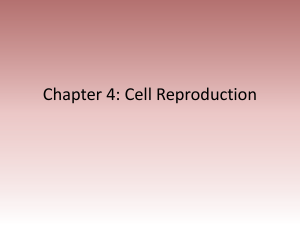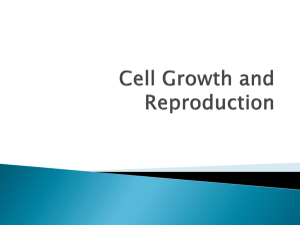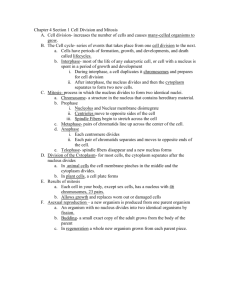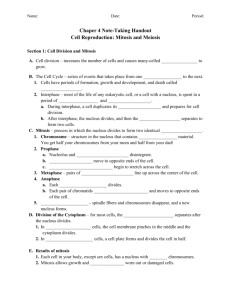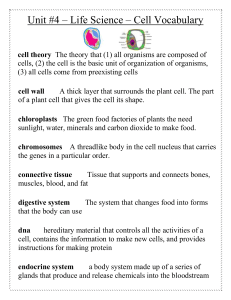Chapter 4
advertisement
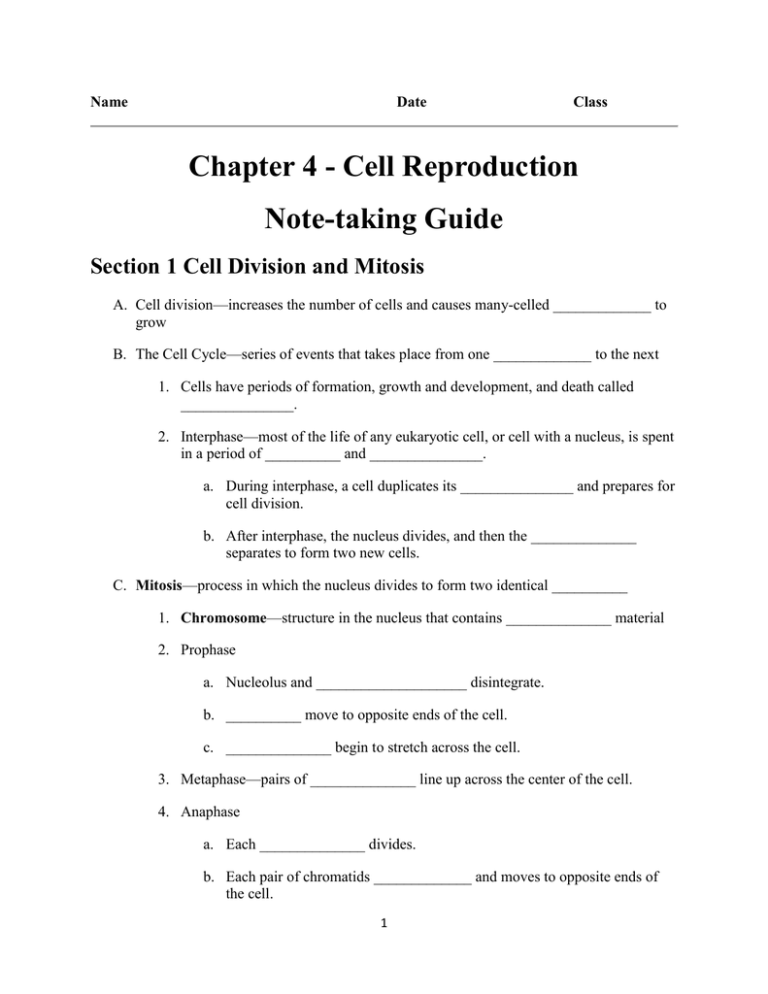
Name Date Class Chapter 4 - Cell Reproduction Note-taking Guide Section 1 Cell Division and Mitosis A. Cell division—increases the number of cells and causes many-celled _____________ to grow B. The Cell Cycle—series of events that takes place from one _____________ to the next 1. Cells have periods of formation, growth and development, and death called _______________. 2. Interphase—most of the life of any eukaryotic cell, or cell with a nucleus, is spent in a period of __________ and _______________. a. During interphase, a cell duplicates its _______________ and prepares for cell division. b. After interphase, the nucleus divides, and then the ______________ separates to form two new cells. C. Mitosis—process in which the nucleus divides to form two identical __________ 1. Chromosome—structure in the nucleus that contains ______________ material 2. Prophase a. Nucleolus and ____________________ disintegrate. b. __________ move to opposite ends of the cell. c. ______________ begin to stretch across the cell. 3. Metaphase—pairs of ______________ line up across the center of the cell. 4. Anaphase a. Each ______________ divides. b. Each pair of chromatids _____________ and moves to opposite ends of the cell. 1 5. _________—spindle fibers disappear and a new nucleus forms. D. Division of the Cytoplasm—for most cells, the _____________ separates after the nucleus divides. 1. In ______________ cells, the cell membrane pinches in the middle and the cytoplasm divides. 2. In ______________ cells, a cell plate forms. E. Results of mitosis 1. Each cell in your body, except sex cells, has a nucleus with ______ chromosomes. 2. Allows growth and ____________ worn out or damaged cells F. ____________________—a new organism is produced from one parent organism. 1. An organism with no nucleus divides into two identical organisms by ___________. 2. _______—a small, exact copy of the adult grows from the body of the parent. 3. In ________________, a whole new organism grows from each piece of the parent. Section 2 Sexual Reproduction and Meiosis A. ______ reproduction—two sex cells, usually an egg and a sperm, come together. 1. Fertilization—the joining of an _______ and a _________, generally from two different organisms of the same species a. Sperm are formed in the ________ reproductive organs. b. Eggs are formed in the __________ reproductive organs. c. A cell that forms from fertilization is a __________. 2. Following fertilization, ___________ begins and a new organism develops. 3. Human body cells are ___________, because they have 23 pairs of similar chromosomes. 4. Human sex cells are ___________, because they have 23 single chromosomes. B. _______—a process that produces haploid sex cells and ensures that offspring have the same ___________ number as its parent. 2 1. In meiosis I, the nucleus divides and produces two new cells with one duplicated ______________ each. 2. In meiosis II, the nuclei divide and the chromatids separate, producing ________ cells with half the number of chromosomes of the original nucleus. Section 3 DNA A. DNA—a ____________ that contains information that an organism needs to grow and function 1. Watson and _________ made an accurate model of DNA in 1953. 2. The structure of DNA is similar to a __________________. a. The sides of the ladder are made up of _____________________________. b. The rungs of the ladder are made up of __________________. 3. Before a cell divides, its DNA duplicates itself by unwinding and separating its sides, then each side becomes a pattern on which a _____________ forms. B. Genes—sections of _______ on a chromosome 1. Contain instructions for making specific ____________ 2. RNA carries the _________ for making proteins from the nucleus to the ribosomes in the cytoplasm. a. Messenger RNA carries the code that directs the order in which the _______________ bond. b. Ribosomal RNA makes up _____________, where proteins are built. c. ________ RNA brings amino acids to the ribosomes to build the protein. 3. Cells use only the _________ that direct the making of proteins needed by that cell. C. Mutations—any permanent __________ in the DNA sequence of a cell's gene or chromosome 1. Can be caused by outside factors like X rays, ____________, and some chemicals 2. A change in a gene or chromosome can change the __________ of an organism. 3
